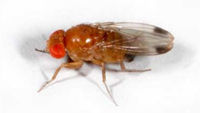|
Spotted
Wing Drosophila Update
by OSU entomologist Vaughn Walton and John Schmitz
 Spotted
Wing Drosophila (SWD), the first Oregon infestations of which were
recorded in August 2009 at a U-pick farm in Benton County, is becoming
an increasing problem in blueberry fields. Spotted
Wing Drosophila (SWD), the first Oregon infestations of which were
recorded in August 2009 at a U-pick farm in Benton County, is becoming
an increasing problem in blueberry fields.
Today it’s estimated that the insect has found its way into
all major blueberry production areas in Oregon.
As Oregon State University horticultural entomologist Vaughn Walton
puts it: “This pest is causing losses, specifically in later
maturing varieties if you do not monitor for it.” He goes
on to add that, “It will not be possible to eradicate it.
It is too widespread and even if specific growers manage it well,
it will continue to invade those areas.”
The good news is that Walton and others at OSU have developed a
website that tells growers all about SWD and how to monitor and
treat for it.
That web address is: swd@hort.oregonstate.edu. “It’s
a very, very widely used website. We’ve gotten more than 100,000
hits already,” Walton said.
The website presents the results of a statewide monitoring program
that shows where SWD outbreaks have occurred in Oregon. “But,
of course, growers have to go out and check for themselves and see
if they have a problem,” Walton said.
Monitoring, the methodology for which is covered at the site, is
a rather detailed process. (“It is quite an effort. You have
to monitor at least weekly,” Walton said.) The site also lists
the various registered insecticides that can be used in both conventional
and organic fields, as well as application rates.
When there is no treatment, SWD can “very easily” claim
up to 40 percent of a crop, Walton said. Once SWD has been discovered,
it’s usually too late to treat for it, he added.
Unlike other destructive pests that overwinter in huge numbers,
only about one percent of drosophila adults survive the winter,
Walton said. However, that little colony soon builds back to the
original numbers as more and more fruit becomes infected.
Another bit of good news, for the most part, is that blueberries
aren’t as badly affected by SWD as other fruit crops, Walton
said. The exception to that is the very late maturing varieties.
Fruit damage occurs when adult females lay their eggs in the fruit
and larvae commence to eat the fruit.
Walton said that when monitoring, growers need to make sure to put
traps not only around the edges of fields but also in surrounding
areas where other fruit, especially wild blackberries, grows.
|
Articles:
Message from the Chairman
Seasonal
In-State Promotions Keep the Spotlight on Oregon Blueberries
Market Update
USHBC
to Discuss Assessment Hike
South
Korea Gets Fresh with Oregon
GAP
Answer to Fruit Safety Concerns
Spotted
Wing Drosophila Update
Blueberry
Production Research at the NWREC Highlights
Blueberry
Tree Project
Blueberries
Dropped from Pristine and Cabrio Labels
2012
Blueberry Day at the Ag Show, January 24, 2012
NRCS
Offers Financial Assistance for Energy Audits
|

 Spotted
Wing Drosophila (SWD), the first Oregon infestations of which were
recorded in August 2009 at a U-pick farm in Benton County, is becoming
an increasing problem in blueberry fields.
Spotted
Wing Drosophila (SWD), the first Oregon infestations of which were
recorded in August 2009 at a U-pick farm in Benton County, is becoming
an increasing problem in blueberry fields.